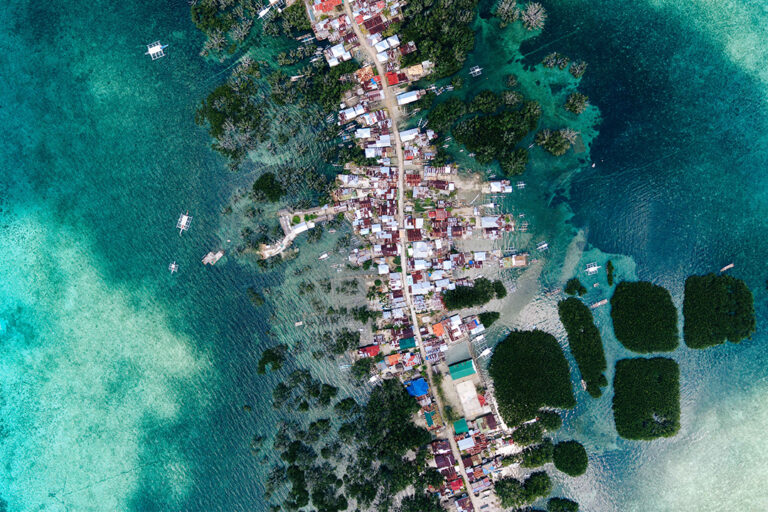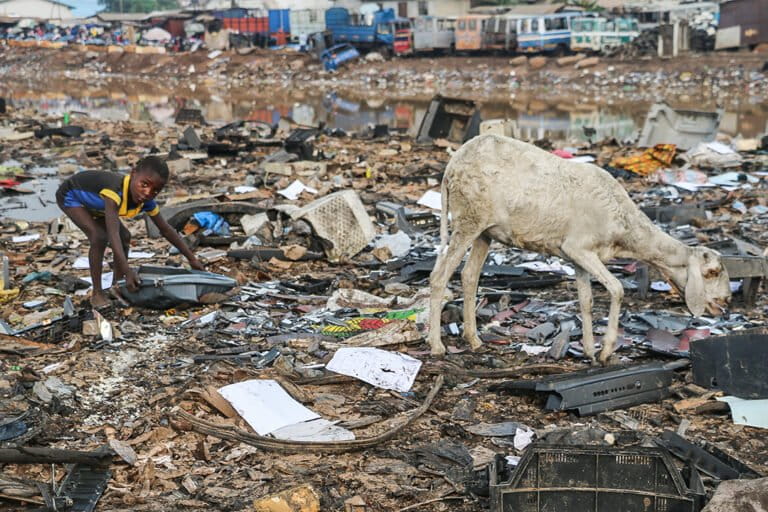- Colombia’s fourth-largest dam, built despite local opposition more than a decade ago, continues to affect the livelihoods of neighboring communities in Colombia’s department of Santander, an area now also targeted by fracking.
- An ecosystem restoration project designed to compensate for the dam’s environmental impact by buying and restoring degraded land within a protected area has pushed locals from their land or left them with unclear tenure rights.
- Women-led associations are demanding the companies involved to respect the rights of local communities and clarify their status.
In La Playa, a fishing village of around 500 people in Santander, Colombia, well-kept houses and vibrant murals live in the shadow of el monstruo — the locals’ nickname for the Hidrosogamoso Dam, a mega project that has challenged local livelihoods and triggered a wave of activism.
Operating since 2014 on the Sogamoso River, Hidrosogamoso is Colombia’s fourth-largest hydroelectric dam. But ISAGEN, the company that built the dam more than a decade ago, now owned by multinational Brookfield Asset Management, failed to consult the community and address concerns about the project’s social and environmental costs, according to local sources. Hidrosogamoso’s reservoir, Topocoro, replaced about 7,000 hectares (17,300 acres) of forest and cropland, causing deforestation and loss of habitat and aquatic species diversity. More than 1,000 people had to relocate, while the livelihoods of those relying on the river for fishing, small-scale mining, and subsistence agriculture suffered, according to Colombia’s Ombudsman’s Office and local NGOs. More than 16,000 people were affected, while community members opposed to the dam faced threats, disappearances, and even killings.

Located in the Magdalena Medio region, Santander is a strategic territory with invaluable natural resources. Here, communities have already lived through decades of unrest and displacement caused by armed conflict, while extractive industries for oil, coal and gold have led to exclusion, inequality and poverty.

But in the case of Hidrosogamoso, it was not just the dam affecting locals in La Playa. Legally required to make amends for its ecological impacts, ISAGEN had to carry out environmental offsetting, by running ecosystem restoration projects around the dam’s reservoir and in Serranía de los Yariguíes National Natural Park, about 100 kilometers (60 miles) from Hidrosogamoso. This brought new restrictions and tenure issues to communities living in the park. But two different activist groups led by women have been fighting for their rights and territories around the dam and in the national park.
Ríos Vivos and the people affected by dams
Promoted as a new symbol of progress in Colombia, hydropower currently accounts for 70% of the country’s energy mix. But across the country, large-scale dams have brought severe impacts to local communities and ecosystems. In response to the impacts of Hidrosogamoso, affected people from across Santander came together in 2008 to create the Social Movement in Defense of the Sogamoso and Chucurí rivers (Ríos Vivos Santander), which advocates for people affected by dams and other extractive projects. The movement is led predominantly by women whose rights and livelihoods were ignored when the dam was built.

Members of Ríos Vivos, academics and local NGOs say the environmental license for Hidrosogamoso was granted in 2000 with little to no public consultation. The first public hearing on the dam took place in 2009, nine years after the environmental license was granted, and a second one for license revision in 2019. Transcripts from those hearings reveal that the locals repeatedly complained about the impacts and rights violations endured by the most marginalized members of the community. Fishers and farmers say they haven’t been included or received compensation beyond symbolic short-term employment. They say they mourn the loss not only of their livelihoods but also of their relationship with the river.
Over a recent video call, four women from the Ríos Vivos movement told Mongabay that the local community continues to feel the long-term impacts of the dam, while also being threatened by pilot fracking projects in the area. The development and employment opportunities promised by ISAGEN are yet to arrive, the women say, while the community has become divided, fighting over the few jobs the company offered. A lawsuit filed by Ríos Vivos against ISAGEN and Colombia’s National Environmental Licensing Authority (ANLA) in 2014 over the damage caused by the dam is still underway.
The community lived for decades with the ebbs and flows of the Sogamoso, a tributary of the Magdalena, the longest river that runs entirely through Colombia. Sometimes water levels rose so much that they had to evacuate to the hills, but shortly after they would return to find that the river had left behind wood, sand and silt for their crops. “He [the river] took from us, but he repaid us many times more,” Cecilia, a fisherwoman in La Playa, told Mongabay. “And so, we coexisted with the river; that’s why there is the saying ‘The good fortune of Sogamoso was lost with Hidrosogamoso.’”

Besides the primary benefit of energy production, those in favor of the dam say it controls flooding, mitigates droughts, and brings employment and tourism. However, the women of Ríos Vivos say the occasional employment brought by the dam or tourism doesn’t come close to compensating for Hidrosogamoso’s permanent impacts.
The unprotected in protected areas
About 100 km from La Playa, deep in the Andes Mountains, 11 families live inside Serranía de los Yariguíes National Natural Park. In 2005, when it was declared a national park, much of the land within its boundaries was still privately owned or occupied. Only some of the occupiers had legal titles. Once the protected area was created, agriculture, vehicles, hunting and logging all became prohibited, undermining the livelihoods of locals depending on growing crops or raising livestock, and severely limiting their access to credit or subsidies.
In Serranía de los Yariguíes, 40 private properties were purchased under an agreement between ISAGEN, parks authority Parques Nacionales Naturales de Colombia, and the NGO Patrimonio Natural. This purchase was part of an offset initiative to compensate for the impacts of the Hidrosogamoso Dam, with ecosystem restoration projects taking place in the park between 2013 and 2018. But landowners and NGOs say the land was undervalued, despite its importance for biodiversity. Some families took the offer and relocated outside the park, on farms sometimes a tenth the size of their original ones, but closer to towns and amenities. Other locals were unprepared to accept the offer or never received one, as they couldn’t prove they formally owned the land, a chronic issue across Colombia. The environmental offsets represented for the state a solution for families living in limbo since the park’s creation. However, contested negotiations and increased pressure to sell the land divided the community and undermined the local economy.
With Colombia’s public institutions chronically underfunded, environmental offset mechanisms have emerged as a way to finance the management of protected areas. The use of offsets within protected areas is contested because of the risk of undermining existing public sector commitments, but in some places offsets are seen as a tool to address the financing gap in the management of protected areas, especially in lower-income countries. Environmental compensation instruments have been a central part of environmental impact assessment standards and laws, in Colombia and globally, since the 1990s. In 2012, Colombia introduced national environmental offsetting legislation to compensate for the environmental harm from development projects by conserving or restoring biodiversity elsewhere, aiming to achieve zero net loss in biodiversity.
Ruby, a landowner with formal property title in the protected area says she no longer trusts the parks authority or ISAGEN, after being left in uncertainty for years. She had to abandon her crops after being told her land was within the protected area, only to be told years later that the land fell outside the perimeter. The park limits were redrawn in 2008, three years after the original declaration of the park, to an area 20,000 hectares (49,400 acres) smaller.
“Now they come to tell me that my property title no longer has that requirement that they had put on it and that now I’m outside of the park,” Ruby said. Some locals see the investment in Serranía de los Yariguíes as a strategic move by ISAGEN to control the dam’s water source high in the mountains. “So now they invest some money there for projects … I was afraid to get involved because it turns out that they weren’t going to buy the land, but pay us quotas. We said no, we didn’t want to get mixed up in that,” Ruby said.
The ecosystem restoration projects in the park were welcomed by many locals. But the community living close to the dam and people in and around the national park said they felt excluded. An independent audit by the Colombian Office of the Controller General found that the offset project in Serranía de los Yariguíes National Natural Park failed to properly involve communities and reported a “coercive approach towards the population settled in the perimeter of the park.”

National parks and protected areas are critical for biodiversity conservation in Colombia, and around the world. However, parks have also become sites of conflict over land use, tenancy and land grabs. There’s no definitive number for the people living within protected areas in Colombia. Estimates vary from 22,000 to more than 90,000. The Asodefensores Yariguíes association was formed by a group of families owning land inside and around the park who were affected by restrictions and wanted their rights recognized. Negotiations between community members and the parks authority have been going on for years, seeking solutions such as payment for ecosystem services or community ecotourism. However, national laws prohibit living within protected areas, except in the case of collective territories of Indigenous and Afro-Colombian communities.
Women resisting violence and disease
A few days before speaking to Mongabay, the four women from Santander had been in lockdown for days, not due to COVID-19 but because of an “armed strike.” The Gulf Clan cartel imposed a strict lockdown across 10 of Colombia’s 32 departments in retaliation for the extradition of the group’s leader to the United States. “We’re in a country where criminality is law … the criminal organizations are the ones that put order in the country,” said Claudia, a leader of the Ríos Vivos movement. In Colombia, the most dangerous country in the world for human rights and environmental defenders, people opposing extractive projects are frequently targeted by criminal groups.
Still, women defenders are making progress in Colombia. Recently elected as the country’s vice president, environmental activist Francia Márquez has promised to represent historically marginalized groups. During their campaign, Márquez and president-elect Gustavo Petro signed a pact to ratify the Escazú Agreement, a landmark treaty in Latin America and the Caribbean guaranteeing the right to access information and participate in environmental decision-making. The government of the outgoing president, Iván Duque, has signed the agreement, but so far failed to approve it. Once ratified, the agreement would offer critical legal protection for environmental defenders such as those of Ríos Vivos and Asodefensores.
Being part of a social movement has helped women across Santander to increasingly recognize and defend their rights in the face of mega projects and also against gender-based violence. For Claudia, defending the environment starts from connecting to the body.
“We continue to have hope, despite the complications that we have in the territories and our own lives, despite the diseases that come with the daily grind of defending and caring for life that also goes through our bodies,” she said. “We have diseases from hydroelectric power, from mining, from oil — that also passes through our bodies. But we continue to have hope, continue to unite, strengthen ourselves to care for our lives.”
Banner image: The Hidrosogamoso Dam transformed the environment and livelihoods of local communities in this part of the department of Santander, Colombia. Image by Motero Colombia via Wikimedia Commons.
Citations:
Githiru, M., King, M. W., Bauche, P., Simon, C., Boles, J., Rindt, C., & Victurine, R. (2015). Should biodiversity offsets help finance underfunded protected areas? Biological Conservation, 191, 819-826. doi:10.1016/j.biocon.2015.07.033
De Pourcq, K., Thomas, E., Arts, B., Vranckx, A., Léon-Sicard, T., & Van Damme, P. (2017). Understanding and resolving conflict between local communities and conservation authorities in Colombia. World Development, 93, 125-135. doi:10.1016/j.worlddev.2016.12.026













